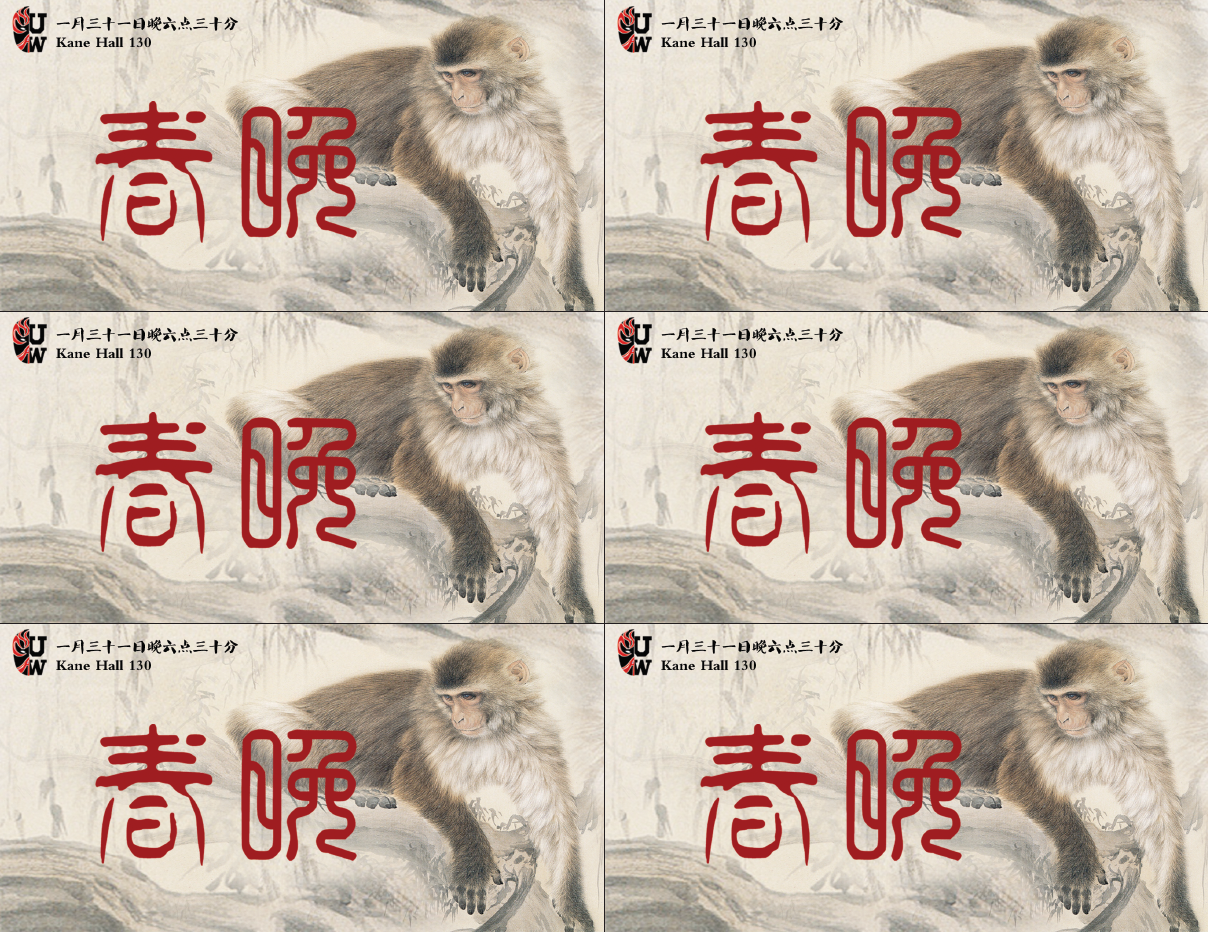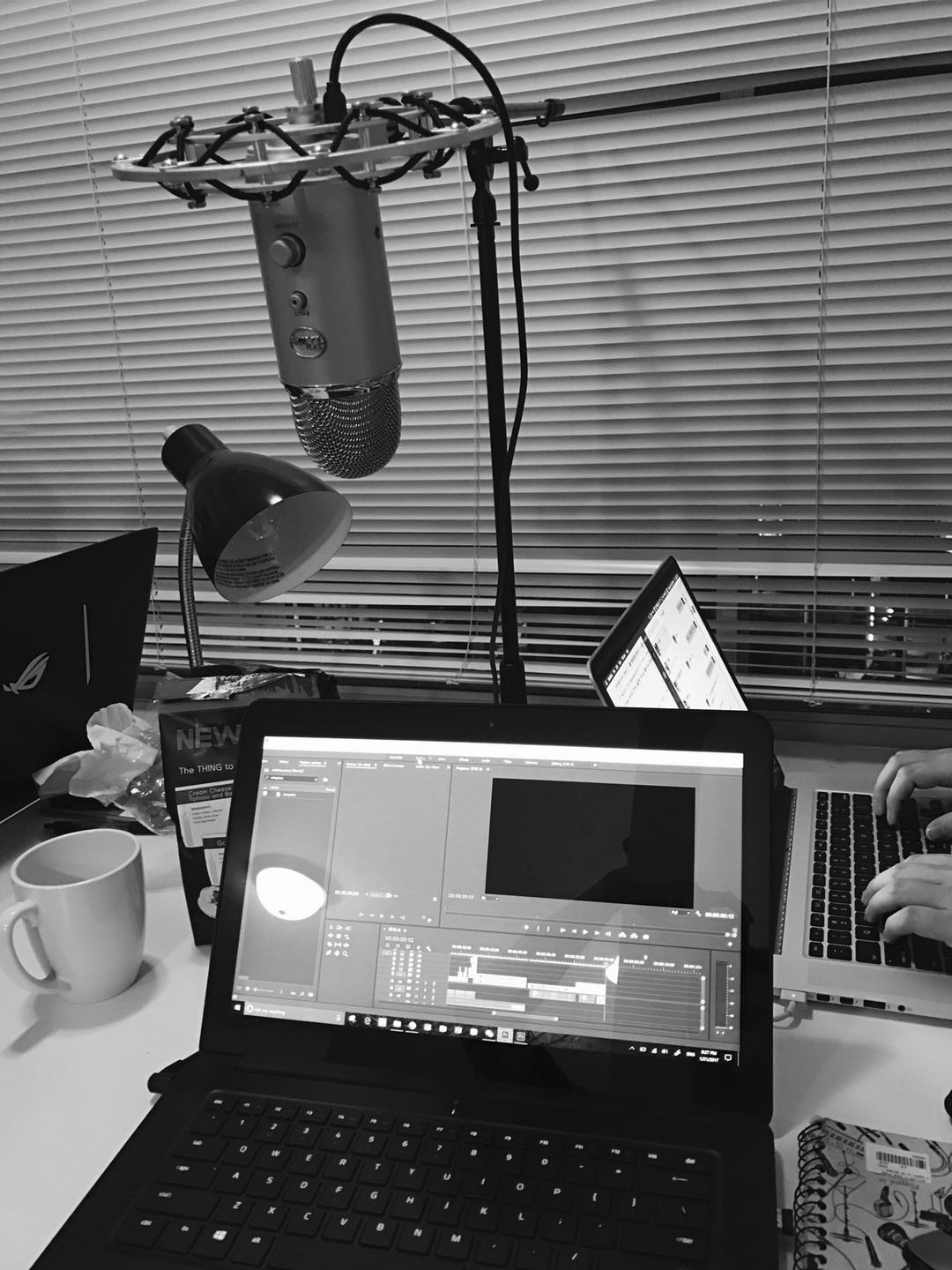The UWCSSA Chinese New Year Gala is the largest annual Chinese new year celebration on the west coast produced by college students. The event takes place at the Kane Hall Auditorium 130 at the University of Washington every year, with over 800 live audiences and 30,000 online audiences. In 2016 and 2017, I was responsible for the media component of the event, which is comprised of graphic design, video production, stage design, sound & lighting effects and technical support.
Project Topics:
Chinese New Year Celebration
Show Production
Event Streaming
Culture & Diversity
Personal contributions:
Project Management (PM)
Graphic Design
Film Directing/Editing
Stage Design
Online Payment Service Support
Online Streaming Service Support
Lottery Software Development
Phase One: PREPARATION
Preparing for such a large scale event is a sophisticated process. As the director of the media team, I was leading a 12-people team of designers and technicians. Due to the tight schedule of the auditorium, the event left us enough time for only one rehearsal, so the preparation must be perfect. There was no tolerance for any mistake during the event.
Promotion Material Design
The event required 3 types of promotional materials: posters, tickets, and pamphlets. As a UX designer, I led the design team to go through human centered design processes, including field research, interviews and affinity diagrams. As a result, we got the inspiration of 2016 as "the year of monkey" and designed monkey themed promotional materials. The following figures are the poster, pamphlet cover page, pamphlet content page, and ticket design.
Video Production
One of the most attracting programs in the Gala is UWCSSA self-made videos. As the media director, I was also the director of those videos. The media content includes 1 promotional video (what you just saw above), 1 intro video, 1 funny video (meme/dubbing style) and 1 emotional video (to make people cry). Four videos generated enormous workload for me, but I had the realization of what it takes to be a video director.
The intro
The intro video was to be played at the beginning of the event. When the light was just shut, the intro video must grab everybody's attention right away, bringing audiences into the "zone" of our show. Therefore, the intro needed to be as emotional and eye catching as possible. I researched many intro videos for large scale events, including Apple product launching events, the Oscars, the Olympics, and the Chinese National New Year celebration, and finally decided on a count down form since it appears to be the most effective way to have people pay attention. If you see a timer, you will automatically watch it until it ends. Later I found out that YouTube embraced the same idea to their ads, making you to stare at the ads for five seconds with full concentration before you can click the "skip" button.
The Funny Video
The funny video serves as a standalone program in the gala. It is so important that we put this video as the second one to our finale. The video is similar to the YouTube Rewind, which concluded all the interesting news, important events, and funny stories happened at the University of Washington in the past year. It also serves the role of a comedian and a commentator to make fun of and criticize things that students don't like. The video should also contain a complete storyline other than just a collection of funny memes. The production of this video took a whole crew several weeks to finish.
The funny video went through multiple revisions before its final form, and my job was to keep the storyline and preventing it from going off topics. Because the crew was consist of many writers who didn't have digital media experiences, they were often unsure whether their idea can be achieved by the media team. Consequently, I also worked as a consultant to answer technical questions and evaluate writers' scripts. The final video is in Chinese. I apologize for the inconvenience, but it contains too many punchlines that are either UW or China related and is difficult to translate.
The emotional Video
The purpose of the "sad video" is not to simply make audiences cry, but remind them how much love they received from their families. As international students, we cannot celebrate the most important Chinese festival with our family because we don't have holidays in January or February. Actually, we often work on our midterm exams during that time. However, we wanted to tell our audiences that their families are always missing them, thinking about them and loving them. So, I asked my team to secretly contacted many students' parents, friends, and significant others, asking them to send us videos of their blessings.
The result surprised me and deeply moved me. Those people in the videos, though most of them apparently were struggling to handle the technology, put so much efforts into those videos. Some dressed up to well; some put a wall of UW themed decorations; some prepared their speech and shot the video in beautiful places. I was constantly amazed by how parents showed their love to their children, but due to the time constraints I cannot show all videos, so I ended up editing two versions. The version I used in the event is a collection of best parts of all videos and specially designed follow up song called "where did the time go?", aming to break people in tears. The other version is a full-length version without any editing. I posted the full version online after the event for students to watch.
Phase Two: Stage Design
Coming to the stage, I got even more work to do. How to place the lighting equipment? What to display in the background? What music to play? How does to lottary thing work? I started tackling these problems one by one.
Background Pictures
Since different programs had different art styles, it was difficult to use the same background picture. However, we still needed the design to be consistent in some way. Hence, I decided to use customized background pictures/videos during individual programs but to use a consistent graphic element with program names in all transition stages. The result was a not only coherent but also individually featured event.






Lighting
Lighting is vital to the visual effect of an event. Since we held the event in an auditorium without any window, lighting control was relatively easier. Nevertheless, the auditorium was a standard staircase classroom with 800 seats and was not designed to be a theater, so there is no dedicated places for sounds/lighting equipment. They had to be placed in positions where audiences could get the effect but couldn't see them.
To minimize distractions, I designed the following placement of lightings, putting crossfaders next to the walls, arranging chase lights on the back of the auditorium, and placing effect projectors in front of the stage but below the audience's eye sights.
The result of lighting design was excellent. Chase lights could catch the performers without any interruption; dead zones were kept dark all the time; effect lights lit the stage as needed. As the following pictures demonstrate, ambient lighting was properly distributed on the stage while the faces of performers were always lit.
Online STREAMING
When preparing this event, I was notified that all 800 tickets got sold out! And we were still two weeks before the event! After the excitement about popularity, I started thinking of ways to increase our audience base. I spent countless hours on this event and hardly slept in weeks, but the number of audiences were capped by 800. I was a little frustrated, so I went on twitch and watched some video games to relax myself.
Wait a minute... Video game streaming!
What a great idea! Then I spent the night watching every single YouTube tutorial about streaming video games, but streaming live videos is a completely different story. There are extra equipment, software and manpower needed. I could easily steam my computer content but I couldn't find any solution to stream videos from a camera to a computer then stream it online. The extra step caught on me. Then, the next day, as I browsed news online, I found my favorite game company, Razer, launched a video capture card. I was curious about what a video capture card does, so I clicked in the news. Then I realized that was the thing I needed to stream my event.
Online streaming requires two service providers, the streaming client and the steaming web service. The client I chose is Open Broadcaster (OBS), an open source streaming client that is free and reliable. The streaming website I chose is bilibili.com. Because a large portion of our audiences are from China, we couldn't use YouTube or Twitch since they are unavailable in that region. I then tested multiple streaming platforms and determined that bilibili.com had the largest user base (this website is really popular in China) and fast speed in both China and the US. However, to stream high quality videos, I also needed a nice camera with a long zoom lens, a camera man to operate the camera, a powerful computer to handle the graphic capture and a technician to operate the computer. I reached out to the project manager of the event and asked for more resources. Initially, my request was denied because they were unsure about the streaming quality. So, I bought the video capture card and used my personal camera and laptop to do a demo to them. The result was impressive. I was convinced that with better equipment and more people, I could stream the video much better and double the number of audiences. Seeing the demo himself, the project manager finally agreed to my proposal. However, I held enormous responsibility to the steaming service because I was the first and only person who knew how that works.
As a result, the online streaming brought us 30,000 additional online audiences, increasing our audience base 36 times. Following the huge gain in audiences, our overall income from sponsors was also skyrocketed.
The top right corner of the first image indicates the real time audience number. The event attracted so many people that our steaming went on the front page of bilibili.com during the event day.
Conclusion
The UWCSSA Chinese New Year Gala was the largest project that I have participated. The event was a result of hard work of over 50 officers. I'd like to acknowledge their contributions here. Aside of the media team, there are director team(responsible for shows), marketing team(responsible for promotion), finance team(responsible for finance), and operation team (responsible for operation). All teams worked together and presented this amazing event that brought 35,000 people unforgetable Chinese New Year experiences.
The following playlists are the recordings of this event in 2016 and 2017, which I was responsible for.
“Me only have one ambition, y’know. I only have one thing I really like to see happen. I like to see mankind live together - black, white, Chinese, everyone - that’s all”

















